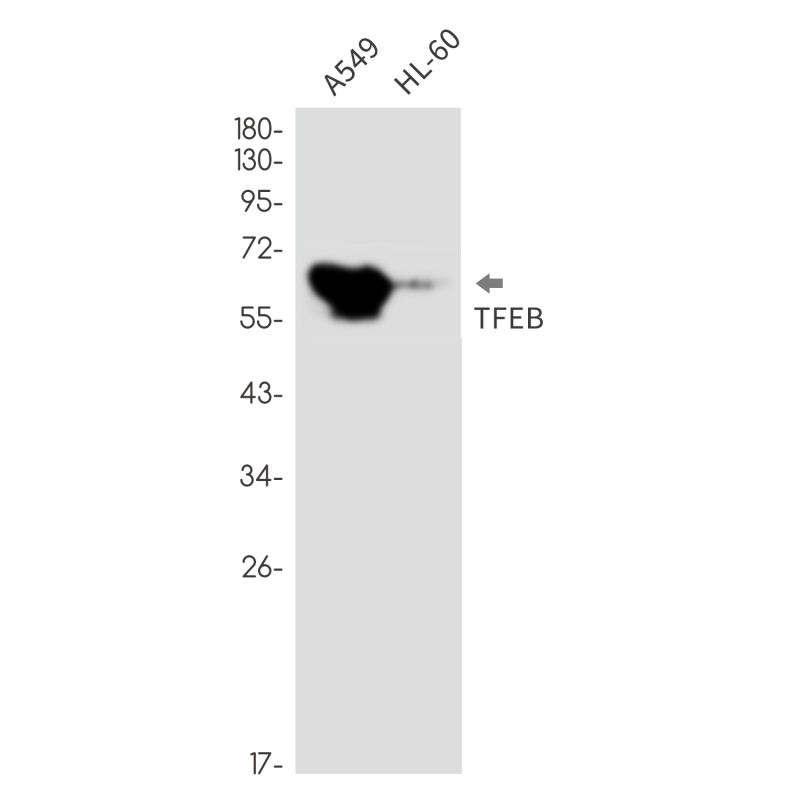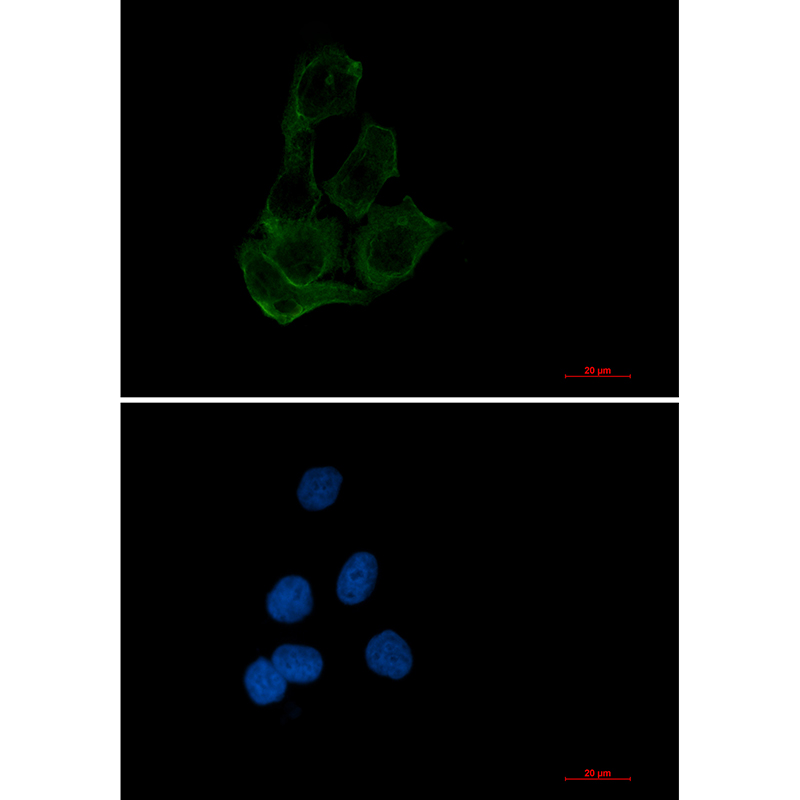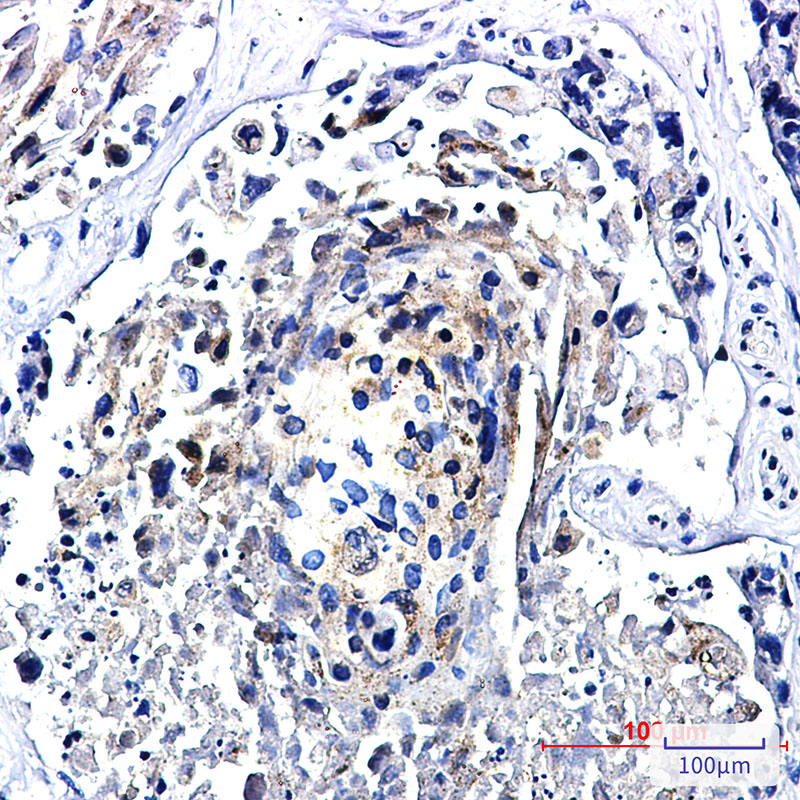


| WB | 1/500-1/1000 | Human,Mouse,Rat |
| IF | 1/20 | Human,Mouse,Rat |
| IHC | 1/50-1/100 | Human,Mouse,Rat |
| ICC | 1/50-1/200 | Human,Mouse,Rat |
| FCM | 咨询技术 | Human,Mouse,Rat |
| Elisa | 咨询技术 | Human,Mouse,Rat |
| Aliases | TFEB; BHLHE35; Transcription factor EB; Class E basic helix-loop-helix protein 35; bHLHe35 |
| Entrez GeneID | 7942 |
| WB Predicted band size | Calculated MW: 53 kDa; Observed MW: 65-70 kDa |
| Host/Isotype | Rabbit IgG |
| Antibody Type | Primary antibody |
| Storage | Store at 4°C short term. Aliquot and store at -20°C long term. Avoid freeze/thaw cycles. |
| Species Reactivity | Human |
| Immunogen | Recombinant protein of human TFEB |
| Formulation | Purified antibody in TBS with 0.05% sodium azide,0.05%BSA and 50% glycerol. |
+ +
以下是关于Transcription Factor EB(TFEB)抗体的3篇参考文献,包括文献名称、作者及简要摘要内容:
---
1. **文献名称**:*A gene network regulating lysosomal biogenesis and function*
**作者**:Sardiello M, et al.
**摘要**:该研究首次阐明TFEB作为调控溶酶体生成和功能的关键转录因子。作者开发了特异性TFEB抗体,通过免疫印迹和免疫荧光验证其在小鼠和人类细胞中的表达及核定位,证实其在溶酶体相关基因表达中的作用。
2. **文献名称**:*TFEB links autophagy to lysosomal biogenesis*
**作者**:Settembre C, et al.
**摘要**:本文揭示TFEB通过调控自噬和溶酶体通路维持细胞稳态。研究中采用兔源多克隆TFEB抗体进行染色,证明其在营养缺乏条件下从胞质转位至细胞核,并激活自噬相关基因的表达。
3. **文献名称**:*TFEB-mediated autophagy rescues midbrain dopamine neurons from α-synuclein toxicity*
**作者**:Decressac M, et al.
**摘要**:研究探讨TFEB在帕金森病模型中的神经保护作用。通过使用小鼠单克隆TFEB抗体进行免疫组化分析,发现激活TFEB可减少α-突触核蛋白聚集,并增强多巴胺神经元的存活。
---
这些文献涵盖了TFEB抗体的开发、验证及其在溶酶体功能、自噬调控和疾病模型中的应用。
Transcription Factor EB (TFEB) is a member of the MiT/TFE family of basic helix-loop-helix leucine zipper transcription factors. It serves as a master regulator of lysosomal biogenesis and autophagy by binding to coordinated lysosomal expression and regulation (CLEAR) elements in the promoters of target genes. TFEB activity is tightly controlled by its subcellular localization: under nutrient-rich conditions, TFEB is phosphorylated by mTORC1 and sequestered in the cytoplasm, while nutrient deprivation or lysosomal stress triggers its dephosphorylation, nuclear translocation, and activation of downstream pathways. Dysregulation of TFEB has been linked to various diseases, including neurodegenerative disorders (e.g., Alzheimer's and Parkinson's), cancer, and lysosomal storage diseases.
Anti-TFEB antibodies are essential tools for studying these processes, enabling detection of TFEB expression, localization, and post-translational modifications. They are widely used in techniques such as Western blotting, immunofluorescence, immunohistochemistry, and chromatin immunoprecipitation. Specific antibodies can distinguish between phosphorylated (inactive) and dephosphorylated (active) forms, providing insights into cellular metabolic states. Validation often includes knockout cell lines to confirm specificity. Researchers utilize these antibodies to explore TFEB's dual roles in cellular homeostasis and pathology, particularly its emerging potential as a therapeutic target for diseases involving lysosomal dysfunction or autophagic flux impairment. Careful selection of antibodies is critical, as isoforms and phosphorylation states may affect experimental interpretation.
×